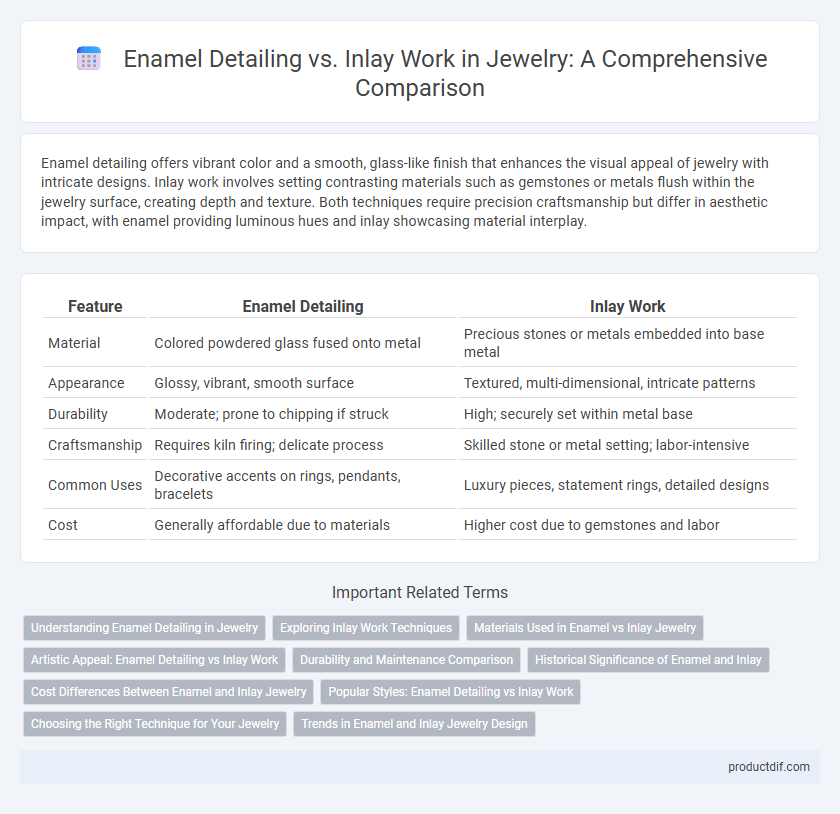Enamel detailing offers vibrant color and a smooth, glass-like finish that enhances the visual appeal of jewelry with intricate designs. Inlay work involves setting contrasting materials such as gemstones or metals flush within the jewelry surface, creating depth and texture. Both techniques require precision craftsmanship but differ in aesthetic impact, with enamel providing luminous hues and inlay showcasing material interplay.
Table of Comparison
| Feature | Enamel Detailing | Inlay Work |
|---|---|---|
| Material | Colored powdered glass fused onto metal | Precious stones or metals embedded into base metal |
| Appearance | Glossy, vibrant, smooth surface | Textured, multi-dimensional, intricate patterns |
| Durability | Moderate; prone to chipping if struck | High; securely set within metal base |
| Craftsmanship | Requires kiln firing; delicate process | Skilled stone or metal setting; labor-intensive |
| Common Uses | Decorative accents on rings, pendants, bracelets | Luxury pieces, statement rings, detailed designs |
| Cost | Generally affordable due to materials | Higher cost due to gemstones and labor |
Understanding Enamel Detailing in Jewelry
Enamel detailing in jewelry involves fusing powdered glass to metal surfaces through high-temperature firing, creating durable, vibrant color patterns that enhance design intricacy. This technique allows for smooth, glossy finishes and rich hues that resist fading, making it ideal for intricate motifs and fine artistic expression. Unlike inlay work, which embeds materials into recessed areas, enamel detailing sits atop the metal, offering versatile textural and visual effects.
Exploring Inlay Work Techniques
Inlay work techniques in jewelry involve embedding contrasting materials such as gemstones, metals, or colored glass into a metal base to create intricate patterns and vibrant designs. This method requires precision crafting to ensure the inlay materials fit seamlessly within carved recesses, enhancing durability and visual appeal. Unlike enamel detailing, which uses powdered glass fused by heat, inlay work allows for diverse textures and a multidimensional effect that highlights artisanal skill.
Materials Used in Enamel vs Inlay Jewelry
Enamel detailing in jewelry involves fusible powdered glass applied to metal surfaces, commonly using materials like copper, silver, or gold as the base, while colors are created by mixing metal oxides. Inlay work incorporates precious stones, mother-of-pearl, or contrasting metals such as turquoise, opal, or malachite set into carved recesses within the metal, often gold or silver. Both techniques demand precision but differ fundamentally in materials: enamel relies on glass and metal oxides, whereas inlay combines hard, polished gemstones or materials embedded into the metal framework.
Artistic Appeal: Enamel Detailing vs Inlay Work
Enamel detailing offers vibrant, glossy color and intricate patterns that enhance jewelry's artistic appeal through smooth, glass-like surfaces. Inlay work showcases a mosaic of carefully set gemstones, metals, or other materials, creating depth and texture with contrasting hues and precision craftsmanship. Both techniques elevate jewelry design by emphasizing unique visual effects, where enamel provides fluid color transitions while inlay delivers bold, structured artistry.
Durability and Maintenance Comparison
Enamel detailing provides vibrant color with a smooth, glass-like finish that resists fading and corrosion, making it highly durable for everyday wear, but it requires careful cleaning to avoid chipping or cracking. Inlay work, often using precious stones or metals embedded into the jewelry surface, offers long-lasting strength and scratch resistance but may demand professional maintenance to keep the inlays secure and polished. Both techniques require specific care routines: enamel benefits from gentle cleaning with mild soap and avoiding harsh chemicals, while inlay pieces need periodic inspection to prevent loosening or damage to the embedded materials.
Historical Significance of Enamel and Inlay
Enamel detailing has been an important technique in jewelry since ancient times, with origins tracing back to the Byzantine and Renaissance periods where it symbolized luxury and intricate craftsmanship. Inlay work, prominent in Native American and Chinese adornments, historically represented cultural storytelling and spiritual significance through the embedding of precious stones or materials into metal. Both methods reflect rich artisanal heritage, with enamel highlighting vibrant color application and inlay showcasing textural contrast and material diversity.
Cost Differences Between Enamel and Inlay Jewelry
Enamel detailing typically involves fusing powdered glass to metal at high temperatures, resulting in vibrant, durable surfaces often more cost-effective than inlay work. Inlay jewelry integrates materials like stones, shells, or metals set into recesses carved into the base metal, which requires intricate craftsmanship and can lead to higher production costs. The labor-intensive process and material diversity in inlay work generally make it pricier compared to the relatively straightforward enamel detailing technique.
Popular Styles: Enamel Detailing vs Inlay Work
Enamel detailing in jewelry showcases vibrant, glass-like color fills that highlight Art Nouveau and Cloisonne styles, emphasizing intricate patterns and vivid contrasts. Inlay work, commonly seen in Southwestern and Native American jewelry, features carefully set materials such as turquoise, coral, or mother-of-pearl embedded into metal surfaces to create mosaic-like designs. Both techniques enhance jewelry aesthetics but differ in texture and visual impact, with enamel producing smooth, glossy finishes and inlay offering a textured, multi-material appearance.
Choosing the Right Technique for Your Jewelry
Enamel detailing offers vibrant, glossy color that enhances intricate designs, making it ideal for jewelry requiring bright, durable finishes with smooth textures. Inlay work involves embedding precious stones or metals into the jewelry base, providing a luxurious, tactile contrast and a bespoke, handcrafted appearance that suits statement pieces. Selecting between enamel and inlay depends on your desired aesthetic, durability needs, and the type of jewelry, with enamel favored for colorful patterns and inlay preferred for artistic depth and material richness.
Trends in Enamel and Inlay Jewelry Design
Enamel detailing in jewelry continues to captivate with vibrant colors and intricate patterns, making it a favored choice for statement pieces and personalized designs. Inlay work gains popularity for its seamless incorporation of diverse materials such as gemstones, wood, and metals, creating striking contrasts and textured effects. Current trends highlight the blend of traditional techniques with contemporary aesthetics, emphasizing sustainability and artisanal craftsmanship in both enamel and inlay jewelry designs.
Enamel Detailing vs Inlay Work Infographic

 productdif.com
productdif.com